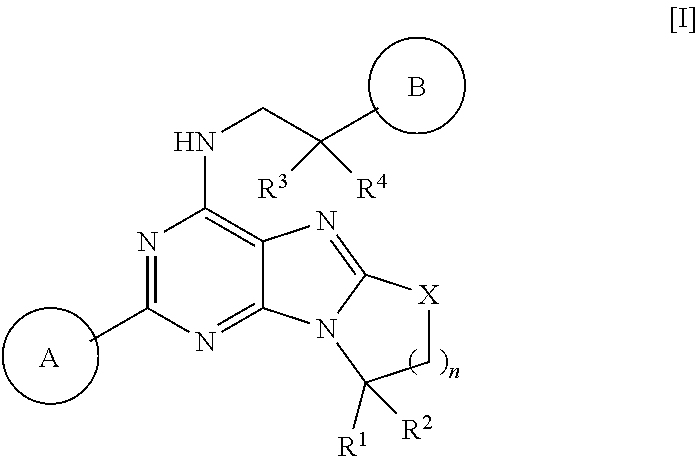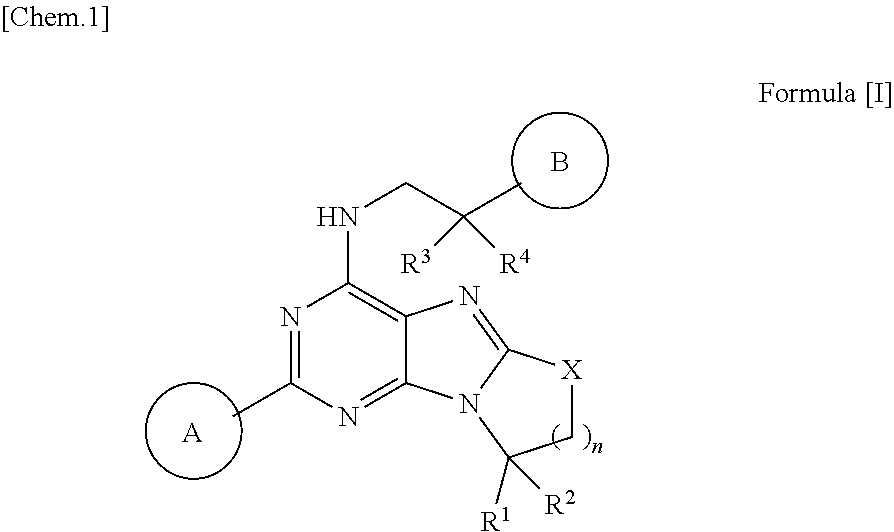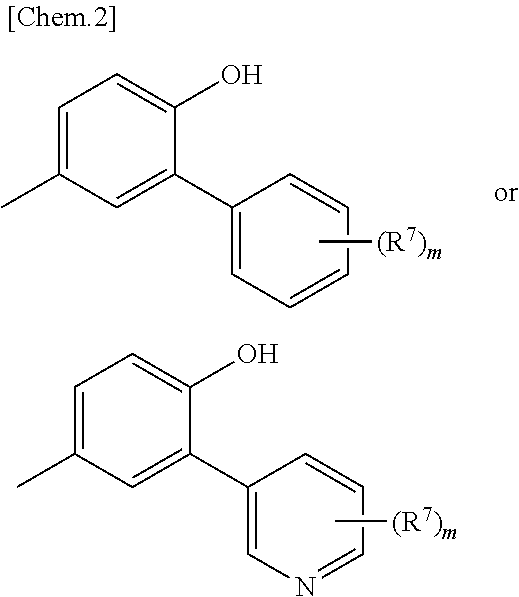Heterocyclic compound
- Summary
- Abstract
- Description
- Claims
- Application Information
AI Technical Summary
Benefits of technology
Problems solved by technology
Method used
Image
Examples
reference example 1
Synthesis of 2-amino-6-chloro-9-(1-hydroxy-2-methylpropan-2-yl)-7H-purin-8-one
[0194]A solution of 2,5-diamino-4,6-dichloropyrimidine (10.0 g) and 2-amino-2-methyl-1-propanol (11.7 ml) in NMP (10 ml) was stirred overnight at 140° C. The reaction mixture was purified by column chromatography (Hexane / AcOEt / MeOH). To a solution of the product in THF (150 ml) was added CDI (19.9 g) at 0° C., and the mixture was stirred for 1 hour. To the mixture were added 50% MeOH aqueous solution (300 ml) and 5 N NaOH aqueous solution (44.7 ml), and the mixture was stirred for 1 hour. The reaction mixture was concentrated, 5 N HCl aqueous solution was added to the residue, and the solid precipitate was collected by filtration to obtain the object compound (10.9 g).
reference example 2
Synthesis of 2-amino-6-chloro-9-(3-hydroxypropyl)-7H-purin-8-one
[0195]A solution of 2,5-diamino-4,6-dichloropyrimidine (1.00 g), 3-amino-1-propanol (0.86 ml), and DIPEA (2.44 ml) in NMP (10 ml) was stirred overnight at 150° C. The reaction mixture was purified by column chromatography (Hexane / AcOEt / MeOH). To a solution of the product in THF (15 ml) was added CDI (2.72 g), and the mixture was stirred for 30 minutes. To the mixture were added 50% MeOH aqueous solution (5 ml) and 5 N NaOH aqueous solution (4.47 ml), and the mixture was stirred overnight. The reaction mixture was concentrated, 5 N HCl aqueous solution was added to the residue, and the solid precipitate was collected by filtration to obtain the object compound (1.11 g).
reference example 3
Synthesis of 2-amino-6-chloro-9-(4-hydroxy-2-methylbutan-2-yl)-7H-purin-8-one
[0196]A solution of 2,5-diamino-4,6-dichloropyrimidine (1.20 g), 3-amino-3-methyl-1-butanol hydrochloride (1.03 g), and DIPEA (2.93 ml) in NMP (6 ml) was stirred overnight at 150° C. The reaction mixture was purified by column chromatography (Hexane / AcOEt / MeOH). To a solution of the product in THF (15 ml) was added CDI (2.17 g), and the mixture was stirred for 30 minutes. To the mixture were added 50% MeOH aqueous solution (20 ml) and 5 N NaOH aqueous solution (5.36 ml), and the mixture was stirred overnight. The reaction mixture was concentrated, 5 N HCl aqueous solution was added to the residue, and the mixture was extracted with AcOEt. The organic layer was washed with saturated saline, dried with anhydrous sodium sulfate and filtered, and the filtrate was concentrated. The residue was purified by column chromatography (AcOEt / Hexane) to obtain the object compound (345 mg).
PUM
| Property | Measurement | Unit |
|---|---|---|
| Molar density | aaaaa | aaaaa |
| Molar density | aaaaa | aaaaa |
| Molar density | aaaaa | aaaaa |
Abstract
Description
Claims
Application Information
 Login to View More
Login to View More - R&D
- Intellectual Property
- Life Sciences
- Materials
- Tech Scout
- Unparalleled Data Quality
- Higher Quality Content
- 60% Fewer Hallucinations
Browse by: Latest US Patents, China's latest patents, Technical Efficacy Thesaurus, Application Domain, Technology Topic, Popular Technical Reports.
© 2025 PatSnap. All rights reserved.Legal|Privacy policy|Modern Slavery Act Transparency Statement|Sitemap|About US| Contact US: help@patsnap.com



